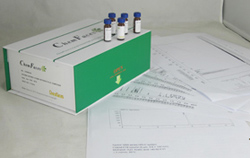Hot Products



| Catalog No. | Information |
| CFN99990 | Tubeimoside I Tubeimoside I shows potent antitumor and antitumor-promoting effects, it is an efficient apoptosis-inducing agent for choriocarcinoma cells, which exerts its effects, at least partially, by the induction of mitochondrial dysfunction and regulation of the p38/MAPK, ERK1/2 and PI3K/Akt signaling pathways. It also shows potent anti-microtubule activity, it can inhibit binding of known tubulin ligands. |
| CFN90915 | Tubeimoside II Tubeimoside I, tubeimoside II, and tubeimoside III show anti-inflammatory, antitumor, and antitumor-promo ting effects. |
| CFN90916 | Tubeimoside III Tubeimoside III has anti-inflammatory, anti-tumor, and anti-tumorigenic activities, stronger than those of tubeimoside II. It has acute toxicity, stronger than that of tubeimoside II. |
| CFN95107 | Tuberosin Tuberosin shows anti-inflammatory and antioxidant activities.It demonstrated a significantly potent inhibition on yeast α-glucosidase in a dose dependent manner. |
| CFN98138 | Tuberostemonine Tuberostemonine has antitussive activity, acts in part as an open-channel blocker at the crayfish neuromuscular junction; it also exhibits relatively higher intestinal permeabilities. |
| CFN96116 | Tubotaiwine Tubotaiwine shows selective activity against L. infantum. Tubotaiwine and apparicine have affinity for adenosine receptors in the micromolar range and also have in-vivo analgesic activity in mice. |
| CFN90669 | Tubuloside A Tubuloside A has anti-inflammatory, antioxidative and hepatoprotective activities. Tubuloside A shows stronger free radical scavenging activities than alpha-tocopherol on 1,1-diphenyl-2-picrylhydrazyl (DPPH) radical and xanthine/xanthine oxidase (XOD) generated superoxide anion radical (O2-.). |
| CFN91712 | Tubuloside B Tubuloside B has the neuroprotective capacity to antagonize TNFalpha-induced apoptosis in SH-SY5Y cells and may be useful in treating some neurodegenerative diseases. Tubuloside B possesses antioxidative effects. Tubuloside B may be applied as an antiparkinsonian agent. |
| CFN95399 | Tumulosic acid Tumulosic acid, a triterpenoid, inhibits KLK5 protease activity (IC50= 14.84 μM). Tumulosic acid suppresses the proteolytic processing of LL-37 in keratinocytes at ≤10 μM. Tumulosic acid reduced, in a dose-dependent manner, nitric oxide (NO) production from lipopolysaccharide (LPS)-induced RAW 264.7 cells. |
| CFN90217 | Turkesterone Turkesterone is a phytoecdysteroid possessing an 11alpha-hydroxyl group, also is an analogue of the insect steroid hormone 20-hydroxyecdysone. It has immunomodulating and antistress activity, can increase the adaptation capacity of mice under immobilization-induced stress conditions. |